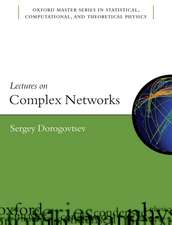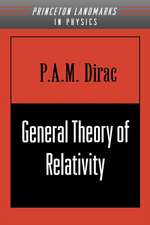The Maximum Entropy Method: Springer Series in Information Sciences, cartea 32
Autor Nailong Wuen Limba Engleză Paperback – 16 sep 2011
Din seria Springer Series in Information Sciences
- 20%
 Preț: 337.66 lei
Preț: 337.66 lei - 18%
 Preț: 955.08 lei
Preț: 955.08 lei - 15%
 Preț: 646.62 lei
Preț: 646.62 lei - 20%
 Preț: 337.52 lei
Preț: 337.52 lei -
 Preț: 385.62 lei
Preț: 385.62 lei -
 Preț: 381.98 lei
Preț: 381.98 lei -
 Preț: 391.61 lei
Preț: 391.61 lei - 20%
 Preț: 324.64 lei
Preț: 324.64 lei -
 Preț: 380.84 lei
Preț: 380.84 lei - 18%
 Preț: 777.69 lei
Preț: 777.69 lei -
 Preț: 387.96 lei
Preț: 387.96 lei -
 Preț: 396.62 lei
Preț: 396.62 lei - 20%
 Preț: 330.75 lei
Preț: 330.75 lei -
 Preț: 382.57 lei
Preț: 382.57 lei - 15%
 Preț: 642.18 lei
Preț: 642.18 lei - 15%
 Preț: 640.06 lei
Preț: 640.06 lei -
 Preț: 387.58 lei
Preț: 387.58 lei - 20%
 Preț: 333.40 lei
Preț: 333.40 lei -
 Preț: 386.99 lei
Preț: 386.99 lei - 20%
 Preț: 653.71 lei
Preț: 653.71 lei - 15%
 Preț: 661.02 lei
Preț: 661.02 lei - 18%
 Preț: 1391.21 lei
Preț: 1391.21 lei - 15%
 Preț: 638.43 lei
Preț: 638.43 lei -
 Preț: 386.00 lei
Preț: 386.00 lei - 20%
 Preț: 649.60 lei
Preț: 649.60 lei - 18%
 Preț: 950.21 lei
Preț: 950.21 lei -
 Preț: 393.35 lei
Preț: 393.35 lei - 20%
 Preț: 652.41 lei
Preț: 652.41 lei - 20%
 Preț: 645.65 lei
Preț: 645.65 lei -
 Preț: 390.25 lei
Preț: 390.25 lei -
 Preț: 387.96 lei
Preț: 387.96 lei - 15%
 Preț: 580.97 lei
Preț: 580.97 lei
Preț: 642.68 lei
Preț vechi: 756.09 lei
-15% Nou
Puncte Express: 964
Preț estimativ în valută:
122.98€ • 128.72$ • 102.36£
122.98€ • 128.72$ • 102.36£
Carte tipărită la comandă
Livrare economică 31 martie-14 aprilie
Preluare comenzi: 021 569.72.76
Specificații
ISBN-13: 9783642644849
ISBN-10: 3642644848
Pagini: 344
Ilustrații: XII, 327 p.
Dimensiuni: 155 x 235 x 18 mm
Greutate: 0.48 kg
Ediția:Softcover reprint of the original 1st ed. 1997
Editura: Springer Berlin, Heidelberg
Colecția Springer
Seria Springer Series in Information Sciences
Locul publicării:Berlin, Heidelberg, Germany
ISBN-10: 3642644848
Pagini: 344
Ilustrații: XII, 327 p.
Dimensiuni: 155 x 235 x 18 mm
Greutate: 0.48 kg
Ediția:Softcover reprint of the original 1st ed. 1997
Editura: Springer Berlin, Heidelberg
Colecția Springer
Seria Springer Series in Information Sciences
Locul publicării:Berlin, Heidelberg, Germany
Public țintă
Professional/practitionerCuprins
1. Introduction.- 1.1 What is the Maximum Entropy Method.- 1.2 Definition of Entropy.- 1.3 Rationale of the Maximum Entropy Method.- 1.4 Present and Future Research.- 2. Maximum Entropy Method MEM1 and Its Application in Spectral Analysis.- 2.1 Definition and Expressions of Entropy H1.- 2.2 Formulation and Solution.- 2.3 Equivalents and Signal Model.- 2.4 Algorithms and Numerical Example (Given ACF).- 2.5 Algorithms and Numerical Example (Given Time Series).- 2.6 Order Selection.- 3. Maximum Entropy Method MEM2 and Its Application in Image Restoration.- 3.1 Definition and Expressions of Entropy H2.- 3.2 Formulation and Implicit Solution.- 3.3 Explicit Solution.- 3.4 Equivalents and Signal Model.- 3.5 R – ? Procedure.- 3.6 Algorithms and Numerical Examples (I).- 3.7 Algorithms and Numerical Examples (II).- 3.8 Algorithms and Numerical Examples (III).- 4. Analysis and Comparison of the Maximum Entropy Method.- 4.1 Generalized MEM.- 4.2 Expressions of Entropy.- 4.3 Solution’s Properties.- 4.4 Resolution Enhancement and Data Extension (Experimental Results).- 4.5 Resolution Enhancement and Data Extension (Theoretical Analysis).- 4.6 Peak Location and Relative Power Estimation (Experimental Results).- 4.7 Peak Location and Relative Power Estimation (Theoretical Analysis).- 4.8 Comments on the Three Schools of Thought on MEM.- 5. Applications of the Maximum Entropy Method in Mathematics and Physics.- 5.1 Solution of Moment Problems.- 5.2 Solution of Integral Equations.- 5.3 Solution of Partial Differential Equations.- 5.4 Predictive Statistical Mechanics.- 5.5 Distributions of Particles Among Energy Levels.- 5.6 Classical Statistical Ensembles.- 5.7 Quantum Statistical Ensembles.- Appendices.- A. Cepstral Analysis.- A.1 Cepstral Analysis System.- A.2 I/O Relationship.-A.3 Properties of the Complex Cepstrum.- A.4 I/O Relationship for Minimum-Phase Input.- B. Image Restoration.- B.1 Image Formation.- B.2 Image Restoration.- B.3 Relationship Between Image Restoration and Spectral Estimation.- References.
Textul de pe ultima copertă
The Maximum Entropy Method addresses the principle and applications of the powerful maximum entropy method (MEM), which has its roots in the principle of maximum entropy introduced into the field of statistical mechanics almost 40 years ago. This method has since been adopted in many areas of science and technology, such as spectral analysis, image restoration, mathematics, and physics. Readers of this monograph are lead to current research frontiers through the analysis and comparison of three schools of thought in MEM research. The step-by-step approach and the detailed examples make this an invaluable textbook for graduate students. The detailed practical algorithms will also appeal to scientists and engineers using this book as a reference work.



















